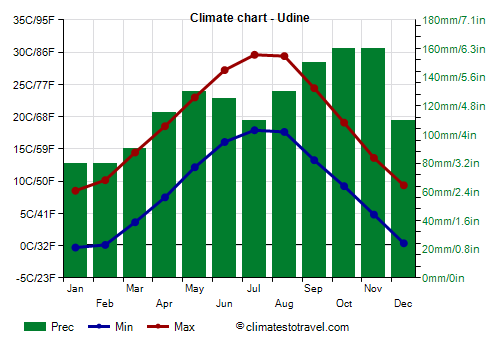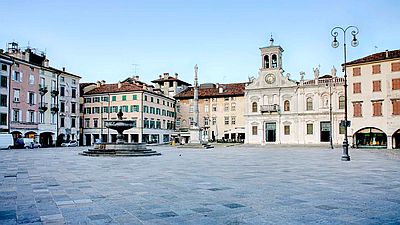Select units of measurement for the temperature and rainfall tables (metric or imperial).
Average weather, temperature, rainfall, sunshine hours

The climate of Udine is
moderately continental, with cold, damp winters and hot, muggy summers.
The city is located in north-eastern Italy, in the Friuli-Venezia Giulia region, in the Venetian plain, which has a slightly milder climate than the Po valley (see Milan, Turin), but also a little more windy, given that it is exposed to both the bora (cold and dry north-east wind) and the sirocco (mild south-east wind).
Also, the climate is
rainy, both due to exposure to the sirocco, and due to the thunderstorms that come from the Alps in late spring and summer.
Winter, from December to February, is cold. There may be cold and foggy periods, in which the temperature remains close to freezing even during the day, although more rarely than in Milan.
Snow in Udine is rare, because with the cold wind from the north-east, the weather is generally dry, while with the sirocco, the wind comes directly from the sea, the temperature exceeds freezing and therefore it rains. Sometimes, however, it can snow. On average, less than 10 cm (4 in) fall per year. Generally, the snow does not exceed 5/10 cm (2/4 in) even in the heaviest snowfalls, although 30 cm (12 in) of snow fell in January 1985.
Every now and then,
cold air masses from Eastern Europe can bring quite intense frosts, though the temperature rarely drops below -10 °C (14 °F). However, at Rivolto airport, the temperature reached -17.5 °C (0.5 °F) in January 1947, -14.5 °C (6 °F) in February 1956, -14 °C (7 °F) in January 1963, -14.5 °C (6 °F) in January 1985, -13 °C (8.5 °F) in January 1987, -12 °C (10.5 °F) in December 2009, -11.5 °C (11.5 °F) in February 1991, and -11 °C (12 °F) in December 1996.
Summer, from June to August, is hot and muggy. The heat is felt because of high humidity, although a bit of breeze comes from the sea in the afternoon.
Sometimes, an Atlantic front, able to bring cool and rainy weather, can affect this area even in summer; more often, on sunny days, thunderstorms can erupt in the afternoon or evening.
During
heat waves, which are becoming increasingly more frequent, the temperature can reach or exceed 35 °C (95 °F). The temperature reached 38 °C (100.5 °F) in July 2006 and August 2017, and 37 °C (98.5 °F) in late June 2017.

Best Time
The
best period to visit Udine is that of spring and early summer, and in particular, from mid-April to mid-June. September, too, is a good month. However, you have to take into account some rainy days in both periods.
Summer can be hot, although some days can be acceptable, especially in June. In summer, and sometimes in May, sudden thunderstorms in the afternoon or evening must be put into account.
Udine - Climate data
In Udine, the
average temperature of the coldest month (January) is of
4.1 °C, that of the warmest month (July) is of
23.7 °C. Here are the average temperatures.
Udine - Average temperatures (1991-2020) |
| Month | Min | Max | Mean |
|---|
| January | -0.3 | 8.5 | 4.1 |
|---|
| February | 0.1 | 10.2 | 5.1 |
|---|
| March | 3.6 | 14.4 | 9 |
|---|
| April | 7.5 | 18.5 | 13 |
|---|
| May | 12.2 | 23 | 17.6 |
|---|
| June | 16.1 | 27.2 | 21.6 |
|---|
| July | 17.9 | 29.6 | 23.7 |
|---|
| August | 17.6 | 29.4 | 23.5 |
|---|
| September | 13.3 | 24.4 | 18.8 |
|---|
| October | 9.2 | 19.1 | 14.2 |
|---|
| November | 4.8 | 13.6 | 9.2 |
|---|
| December | 0.4 | 9.4 | 4.9 |
|---|
| Year | 8.6 | 19 | 13.75 |
|---|
amounts to
1440 millimeters per year: it is therefore quite abundant. It ranges from
80 millimeters in the driest months (January, February) to
160 millimeters in the wettest ones (October, November) Here is the average precipitation.
Udine - Average precipitation| Month | Days |
|---|
| January | 80 | 6 |
|---|
| February | 80 | 5 |
|---|
| March | 90 | 8 |
|---|
| April | 115 | 10 |
|---|
| May | 130 | 11 |
|---|
| June | 125 | 11 |
|---|
| July | 110 | 8 |
|---|
| August | 130 | 7 |
|---|
| September | 150 | 7 |
|---|
| October | 160 | 8 |
|---|
| November | 160 | 7 |
|---|
| December | 110 | 7 |
|---|
| Year | 1440 | 95 |
|---|
There are on average around 2195
sunshine hours per year. Here are the average hours of sunshine per day.
Udine - Sunshine hours| Month | Average | Total |
|---|
| January | 4 | 120 |
|---|
| February | 5 | 145 |
|---|
| March | 4.5 | 145 |
|---|
| April | 6 | 185 |
|---|
| May | 7 | 225 |
|---|
| June | 8 | 235 |
|---|
| July | 9 | 280 |
|---|
| August | 8.5 | 265 |
|---|
| September | 6.5 | 200 |
|---|
| October | 5.5 | 165 |
|---|
| November | 4 | 125 |
|---|
| December | 3.5 | 100 |
|---|
| Year | 6 | 2195 |
|---|